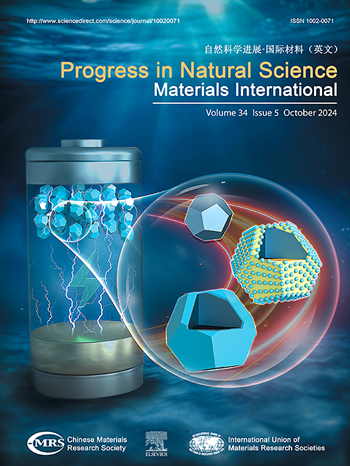Hydrothermal-deposition synthesis of MnO2/MnS nanorods as high-performance asymmetric supercapacitor positive electrode materials
IF 7.1
2区 材料科学
Q2 MATERIALS SCIENCE, MULTIDISCIPLINARY
Progress in Natural Science: Materials International
Pub Date : 2024-10-01
DOI:10.1016/j.pnsc.2024.07.023
引用次数: 0
Abstract
Nanostructuring has shown promise in enhancing the performance of MnO2 for energy storage in supercapacitors, highlighting its technological significance. This study introduces an innovative synthesis method, employing hydrothermal and constant-pressure deposition techniques, to produce nanostructured MnO2/MnS rod electrodes on nickel foam. The roded heterostructure enhances specific surface area, conductivity, and symbiotic effect between MnO2 and MnS. With optimized material and structural advantages, the electrode reaches a capacitance of 977.6 F g−1 at 1 A g−1, demonstrating extended cycling lifespan. Using MnO2/MnS-5h rods as the positive electrode and activated carbon as the negative electrode, the supercapacitor achieves an energy density of 122.23 Wh kg−1 at 898.75 W kg−1. Notably, it maintains 91.55 % capacity retention after 5000 cycles at 10 A g−1, indicating outstanding cycling stability. This research presents a promising solution for efficient energy storage, emphasizing the potential application of the developed MnO2/MnS based supercapacitor in high-performance energy storage systems.
水热沉积合成 MnO2/MnS 纳米棒作为高性能不对称超级电容器正极材料
纳米结构有望提高 MnO2 在超级电容器中的储能性能,凸显了其技术意义。本研究介绍了一种创新的合成方法,采用水热法和恒压沉积技术在泡沫镍上制备纳米结构的 MnO2/MnS 棒电极。棒状异质结构提高了比表面积、导电性以及 MnO2 和 MnS 之间的共生效应。凭借优化的材料和结构优势,该电极在 1 A g-1 电流条件下的电容达到了 977.6 F g-1,显示出更长的循环寿命。该超级电容器以 MnO2/MnS-5h 棒为正极,以活性炭为负极,在 898.75 W kg-1 的条件下实现了 122.23 Wh kg-1 的能量密度。值得注意的是,在 10 A g-1 的条件下循环 5000 次后,它仍能保持 91.55 % 的容量,显示出出色的循环稳定性。这项研究为高效储能提供了一种前景广阔的解决方案,强调了所开发的基于 MnO2/MnS 的超级电容器在高性能储能系统中的潜在应用。
本文章由计算机程序翻译,如有差异,请以英文原文为准。
求助全文
约1分钟内获得全文
求助全文
来源期刊
CiteScore
8.60
自引率
2.10%
发文量
2812
审稿时长
49 days
期刊介绍:
Progress in Natural Science: Materials International provides scientists and engineers throughout the world with a central vehicle for the exchange and dissemination of basic theoretical studies and applied research of advanced materials. The emphasis is placed on original research, both analytical and experimental, which is of permanent interest to engineers and scientists, covering all aspects of new materials and technologies, such as, energy and environmental materials; advanced structural materials; advanced transportation materials, functional and electronic materials; nano-scale and amorphous materials; health and biological materials; materials modeling and simulation; materials characterization; and so on. The latest research achievements and innovative papers in basic theoretical studies and applied research of material science will be carefully selected and promptly reported. Thus, the aim of this Journal is to serve the global materials science and technology community with the latest research findings.
As a service to readers, an international bibliography of recent publications in advanced materials is published bimonthly.

 求助内容:
求助内容: 应助结果提醒方式:
应助结果提醒方式:


